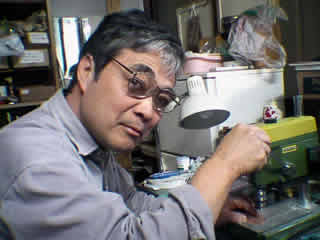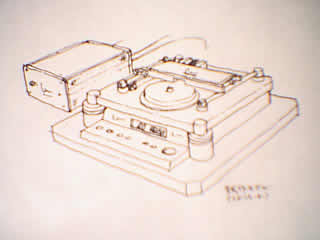![[The 47 Labs headquarters: a typical upper-middle class residence found in suburban Tokyo]](../jpeg/001Aoverview.jpg)
The 47 Labs headquarters: a typical upper-middle
class residence found in suburban Tokyo.
Factory: 47 Laboratories - Japan
Reporter: Hiroshi Iwata
Published: November, 2001
The 47 Laboratories stands for "Kimura Labs". This is not a joke -- the name surely indicates that the lab belongs to Mr. Junji Kimura. The trick here is in the resistor color codes: those stripes printed onto tiny resistor surface to show digit, multiplier and tolerance figures. And in this case, the key to decipher the code "47" must be interpreted in the Japanese language, here's a translation.
The figure "4" is shown with yellow color, and yellow is called "ki" in Japanese: "7" is purple and pronounced "mura(saki)" respectively. Putting them together, the code "47" dissolves into "ki-mura." This half-joking attitude is another important key to deciphering the 47 Labs products, but I'll explain it later in this story.
The 47 Labs headquarters: a typical upper-middle |
The 47 Labs are located in Kichijoji, one of the largest and busiest towns in suburban Tokyo. The town is in fact not far from downtown Tokyo; all you need is to put up with the deadly-crowded train for about 20 minutes. Finding out the correct exit may be a disaster, since the signs written in English (sorry, no other languages) are generally very poor, but once you succeed in getting out of the Kichijoji station, 47 Labs are only a 5 minute walk away. If you want to visit 47 Labs, however, you'd do better to contact your local distributor or dealer and ask him/her to arrange your own "Factory Tour".
![[The round plate is one of the two signs to indicate that this is the entrance to 47 Labs]](../jpeg/002Adoor.jpg) The round plate is one of the two signs to indicate that this is the entrance to 47 Labs. |
Entering the front door, the small space (about 3m X 3m) to the left is the 47 Labs' makeshift listening room. Since the room is usually stowed with boxes and other packaging materials, Kimura himself had emptied the room to prepare our factory tour.
The 47 Labs reference system that I auditioned were comprised of: 4704 PiTracer CD Transport (pronounced pai-tracer), 4705 Progression DAC, 4706 amplifier and "Essence" prototype speaker utilizing Jordan aluminum single-cone unit, built by the company's distributor Konus Audio Systems (Bosnia and Herzegovina).
Interconnects and speaker cables were 4708 Stratos cables and plugs, carefully deployed to minimize mechanical stress to the plugs.
New and old 47 Labs standard monitor speakers. Watch for idiosyncratic "stress-free" wiring. |
The first disc he played was The King's Singers "Good Vibrations," and the sound reproduced was fabulous. Definite imaging, just proper soundstage, with a good timing. To probe other aspects like frequency bandwidth, I asked Kimura to play Basia's "The Sweetest Illusion." This album is one of my "reference" CDs, for its natural, full-range recording. What's more, due to unfavorable sales figures, the CD (new) is sold around 6 US$ at several used-CD shops.
Anyway, the Basia tracks showed the speaker's "lean" balance (I don't mean the total system balance, of course). Kimura says that the balance is OK for him because the speaker provides "quick" and "coherent" sound that are critical to reproduce the music's "liveliness." Since it is "quite difficult to drive 15-inch woofers and 1-inch at exactly the same timing," he uses the single-cone speakers at this moment. Kimura likes to listen to classical music, especially the cello music. He doesn't like those synthesized bass notes and says that his system is not intended for the music using electric basso continuo.
There are rumors suggesting a new "ceramic-boxed" speakers, but there isn't any actually listed on their current catalog. Nonetheless, there could be one in the future. The prototype Kimura showed me (it didn't make sound at all) seemed to be totally different from existing motor-driven speakers. Like other 47 Labs products, the speakers will surely come with unusual "twist" when they are available.
![[Of the silver- and black-colored prototypes, the frayed black one bundled with brown duct tape is the very first prototype of PiTracer]](../jpeg/005Aprototypes.jpg) Of the silver- and black-colored prototypes, |
 Each 4704 PiTracer is assembled by |
While talking about the reference system's sound, some things were tingling my mind: prototypes of a CD transport. They were (there were at least four of them) early models of the 4704 PiTracer, ant the oldest one was made a little bit more than a decade ago. This is the reason why his latest creation has a model code smaller than his first product, the 4706 gaincard.
|
What Kimura holds is the essence of 4706 |
Aside from its designation, the 4704 was somewhat strange stuff to me. The first time I've read about the product, some questions arose in my mind. "Has 47 Labs' minimalist approach changed?" and "Does the 4704's price (25,000 US$ excluding power supply) indicate their new directions - towards so-called high end?" The answer was here - piles of prototypes covered with dust. Now I understand that the CD transport's steep price reflects over ten years of model-making costs and not 47 Labs' change of policy.
![[An early drawing of Kimura's amplifier]](../jpeg/006Adrawing.jpg) An early drawing of Kimura's amplifier. |
 In this drawing, the 47 Labs CD transport |
One last thing regarding the 4704. Each PiTracer is assembled by Kimura himself. I forgot to ask him whether the CD transport has the creator/builder's autograph on it, but the lucky purchasers of the PiTracer can be rest assured that his/her gem is a 100% genuine Kimura.
The kit comprises 50 meter-long "Stratos" 0.4 mm OFC wire and 12 pairs of machined plastic RCA male plugs, plus manual. First timers to 47 Labs and non hi-fi aficionados may be shocked by the kit's listed price of 600 US$, especially when taking a good look at it. It's totally opposite to "luxurious" or "high-end" stuffs and look definitely different from other interconnects when assembled. The sound the kit provides is also intriguing (see excellent review by Geoff Husband and Werner Ogiers here on TNT).
The kit is intended for those who are willing to spend a lot of money for a bundle of very fine copper lines and odd-looking plastic plugs to play one's favorite music with top-notch sound quality. This special kind of people is called in various ways - aficionado, fan, or mania. The 4708's name "Ota Kit" can literally be translated as "nerds kit." Kimura does not mean the kit is for nerds: the name indicates that the creator himself is a nerd. No manufacturer has gone this far to minimize signal loss between components, other than a "nerd" like Kimura.
A visit to 47 Labs was quite interesting experience to me. As mentioned above, Kimura's creations are not intended for all kinds of hi-fi fans. The 47 Labs products are exclusive to those who can understand Kimura's sense of values. This is the reason why there are only a handful of dealerships in Japanese domestic market. Kimura is not a difficult person, though. He's a real gentleman but doesn't compromise when it comes to the world of hi-fi. If you are lucky enough to have some free time in Tokyo or other Asian cities, visiting Junji Kimura's atelier will be an unforgettable experience. You bet.
© Copyright 2001 Hiroshi Iwata - http://www.tnt-audio.com
HTML: Michael McDonald